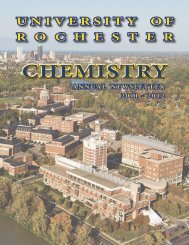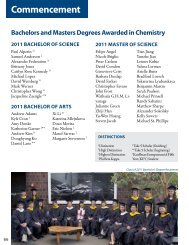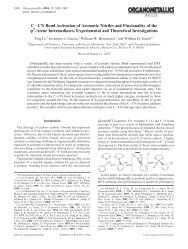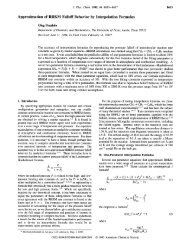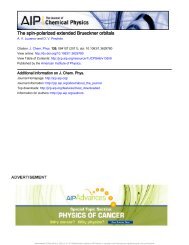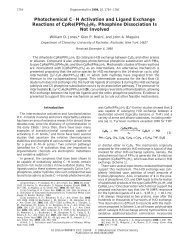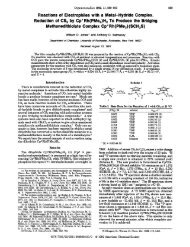Matthew Z. Yates - University of Rochester
Matthew Z. Yates - University of Rochester
Matthew Z. Yates - University of Rochester
Create successful ePaper yourself
Turn your PDF publications into a flip-book with our unique Google optimized e-Paper software.
URChE<br />
Synthesis <strong>of</strong> Proton Conducting<br />
Ceramic Membranes via<br />
Seeded Surface Crystallization<br />
<strong>Matthew</strong> Z. <strong>Yates</strong><br />
Department <strong>of</strong> Chemical Engineering<br />
Laboratory for Laser Energetics<br />
<strong>University</strong> <strong>of</strong> <strong>Rochester</strong>
URChE<br />
Proton Exchange Membrane Fuel Cells<br />
Fuel (H 2 )<br />
H 2<br />
H +<br />
H +<br />
e -<br />
e -<br />
H 2 O<br />
Oxidant (Air/O 2 )<br />
1/2O 2<br />
Anode Electrolyte Cathode<br />
• Advantages: high efficiency, low emission, simplicity, and silence.<br />
• Applications: portable, mobile, and stationery power sources.
URChE<br />
Fuel Cell Types<br />
PEMFC AFC PAFC p-SOFC MCFC SOFC<br />
Electrolyte<br />
Proton<br />
conducting<br />
polymer<br />
(Nafion)<br />
30 to 50%<br />
solution <strong>of</strong><br />
potassium<br />
hydroxide<br />
(KOH)<br />
100%<br />
phosphoric<br />
acid (H 3 PO 4 )<br />
Ceramic<br />
YSZ/Gd-<br />
CeO 2<br />
Molten<br />
carbonates<br />
in LiAlO 3 ,<br />
Li 2 CO 3 /Na 2 C<br />
O 3<br />
Ceramic<br />
<strong>of</strong> 5YSZ<br />
or 8YSZ<br />
Charge<br />
carrier<br />
H + OH - H + H + CO 3<br />
2-<br />
O 2-<br />
Operating<br />
temperature<br />
80 to<br />
120°C<br />
23 to<br />
250°C<br />
150 to<br />
220°C<br />
300 to<br />
700°C<br />
~650°C<br />
700 to<br />
1300°C<br />
Adapted from: Larminie, J.; Dicks, A., Fuel cell systems explained. 2 nd ed.; 2003.
URChE<br />
Research Needs for Fuel Cell Membranes<br />
Power Density (W/cm 2 )<br />
1.5<br />
1.0<br />
PEMFC<br />
0.5<br />
Breakthrough<br />
Membranes<br />
SOFC<br />
PAFC<br />
MCFC<br />
0 200 400 600 800<br />
Temperature (°C)<br />
Ease <strong>of</strong> hydrocarbon reforming<br />
Ease <strong>of</strong> fuel cell construction<br />
PEFC: Polymer electrolyte fuel cells MCFC: Molten carbonate fuel cells<br />
PAFC: Phosphoric acid fuel cells SOFC: Solid oxide fuel cells<br />
Adapted from: Ito, et al J. Power Sources, 2005
URChE<br />
Hydrogen Membrane Fuel Cell (Toyota)<br />
On-board<br />
reformer<br />
H 2<br />
gases<br />
e -<br />
H +<br />
H +<br />
e -<br />
H 2 O<br />
Air/O 2<br />
1/2O 2<br />
Palladium<br />
membrane<br />
Anode Electrolyte Cathode<br />
Ito, et al J. Power Sources 2005:<br />
demonstrated 1.4 W/cm 2 at 600°C using 700 nm thick ceramic electrolyte
URChE<br />
Membrane Development for Intermediate<br />
Temperature Fuel Cells<br />
• Create new materials with high ion conductivity<br />
--- O 2- conductive ceramics: fluorite-, perovskite-, apatite-,<br />
and brownmillerite-based oxides<br />
--- H + conductive ceramics: perovskite oxides, fluorite-related<br />
binary oxides, and apatite phosphates<br />
• Reduce existing SOFC membrane thickness to lower ohmic<br />
resistance <strong>of</strong> ceramic electrolytes<br />
• Engineer membrane microstructures (orientation <strong>of</strong> crystals,<br />
grains, or grain boundaries) to optimize ion conduction<br />
Objective
URChE<br />
Hydroxyapatite Ceramic as a<br />
Proton Conducting Membrane<br />
HAP: Ca 10 (PO 4 ) 6 (OH) 2<br />
(a) (b)<br />
H +<br />
c-axis<br />
O 2- <strong>of</strong> PO<br />
3-<br />
4<br />
Ca 2+<br />
OH -<br />
(c)<br />
b-axis<br />
a-axis<br />
c-axis<br />
(a) typical shape <strong>of</strong> a HAP single crystal; (b) atomic environment around OH - ions;<br />
(c) proton transportation along the c-axis <strong>of</strong> HAP.<br />
Adapted from: Satoshi Nakamura, et al., J. Applied Phys. 2001, 89, 5386-5392.
URChE<br />
Proposed Idealized Hydroxyapatite<br />
Membrane Structure<br />
c-axis<br />
c-axis<br />
Ideal HAP membrane structure: the c-axes <strong>of</strong> crystal<br />
domains span the membrane to optimize proton transport.
URChE<br />
Tertiary Growth Process for Creating<br />
Idealized Hydroxyapatite Membrane<br />
(a) (b) (c)<br />
• Seeding: electrochemical deposition to seed HAP on Pd substrate;<br />
• Secondary growth: hydrothermal deposition under conditions that favor<br />
c-out-<strong>of</strong>-plane growth to yield oriented columnar crystals;<br />
• Tertiary growth: hydrothermal deposition under conditions that favor a-<br />
plane growth to obtain oriented continuous crystalline films.<br />
Lai, Z. P., et al., Science, 2003, 300, 456.<br />
Karanikolos, G. N., et al., Chem. Mater. 2007, 19, 792.
URChE<br />
Hydroxyapatite Seed Layer Grown<br />
on Pd Membrane<br />
Top-view Side-view<br />
~1.5 µm<br />
• Set-up: Pd-cathode, Pt-Anode, current=9.3mA/cm 2 ,<br />
deposited at T=95 o C for 4 min.<br />
• Electrolyte solution: 50mM Tris, 137.8mM NaCl, 2.5mM<br />
CaCl 2 , 1.67mM K 2 HPO 4 , pH= 7.20 adjusted with 37% HCl.<br />
Pt<br />
Pd<br />
Ban, et al., J. Biomed. Mater. Res. 1998, 42, 387.
URChE<br />
Secondary Hydrothermal Growth <strong>of</strong><br />
Hydroxyapatite on Seeded Pd Membrane<br />
Top-view Side-view<br />
~7µm<br />
• HAP solution: 0.1M Ca(NO 3 ) 2 , 0.06M (NH 4 ) 2 HPO 4 ,<br />
0.1M Na 2 EDTA, pH=10 adjusted with 28% NH 4 OH.<br />
• Set-up: HAP/Pd facing to the bottom <strong>of</strong> PTFE liner,<br />
reaction at T=200 o C for 15 hours.<br />
PTFE liner<br />
HAP solution<br />
PTFE plate<br />
HAP/Pd
URChE<br />
Surfactant-Promoted a-axis Growth to<br />
Create Dense Membranes<br />
c-axis<br />
- c<br />
Anionic<br />
surfactant<br />
-<br />
-<br />
-<br />
-<br />
-<br />
a +<br />
-<br />
b-axis<br />
a-axis<br />
a-planes: positively charged<br />
c-planes: negatively charged<br />
Cationic<br />
surfactant<br />
+<br />
+<br />
+<br />
+<br />
Kawasaki, T., Journal <strong>of</strong> Chromatography 1991, 544, 147.
URChE<br />
Surfactant-Modified Tertiary Growth<br />
on Pd Membrane<br />
Top-view Side-view<br />
~25 µm<br />
• HAP solution: 0.1M Ca(NO 3 ) 2 , 0.06M (NH 4 ) 2 HPO 4 ,<br />
0.1M Na 2 EDTA, 0.01M Cetylpyridinium Chloride,<br />
pH=8 adjusted with 28% NH 4 OH.<br />
• Set-up: HAP/Pd facing to the bottom <strong>of</strong> PTFE liner,<br />
reaction at T=200 o C for 15 hours. (repeat 3 times)<br />
Cetylpyridinium<br />
Chloride
URChE<br />
XRD Patterns <strong>of</strong> Hydroxyapatite Membranes<br />
HAP 3 rd growth<br />
(002)<br />
Intensity (a.u.)<br />
HAP 2 nd growth<br />
HAP seeds<br />
(211)<br />
HAP powder<br />
(300)<br />
20 22 24 26 28 30 32 34 36 38<br />
2 θ (degree)
URChE<br />
Proton Conductivity (σ) <strong>of</strong> 25 micron thick<br />
Hydroxyapatite Membrane<br />
10 -2<br />
10 -3<br />
10 -4<br />
Introduce H 2<br />
σ (s/cm)<br />
10 -5<br />
10 -6<br />
10 -7<br />
10 -8<br />
N 2<br />
atmosphere<br />
H 2<br />
atmosphere<br />
10 -9<br />
0 200 400 600 800 1000<br />
T ( o C)<br />
• Literature data: σ~ 5 x 10 -7 s/cm -1 measured at 800 ° C on a sintered<br />
~1 mm thick disc.<br />
Yamashita, K., et al., Solid State Ionics 1990, 40-41, 918.
URChE<br />
Area Specific Resistance (ASR)<br />
<strong>of</strong> Hydroxyapatite Membrane<br />
N 2<br />
atmosphere-25μm thick<br />
10 6 0.5(Ω cm 2 )<br />
N 2<br />
atmosphere-2.5μm thick<br />
N 2<br />
atmosphere-0.5μm thick<br />
ASR (Ω cm 2 )<br />
10 4<br />
10 2<br />
10 0<br />
0.1(Ω cm 2 )<br />
H 2<br />
atmosphere-25μm thick<br />
H 2<br />
atmosphere-2.5μm thick<br />
H 2<br />
atmosphere-0.5μm thick<br />
10 -2<br />
0 200 400 600 800 1000<br />
T ( o C)<br />
Steele, B. C. H. and Heinzel, A., Nature 2001, 414, 345.
URChE<br />
Reducing Membrane Thickness<br />
• Shorter HAP seeding time (2 min)<br />
• Lower (NH 4 ) 2 HPO 4 concentration (0.01 M)<br />
• Film thickness ~ 5µm<br />
• Shorter HAP seeding time (1 min)<br />
• Lower (NH 4 ) 2 HPO 4 concentration (0.01 M)<br />
• Film thickness ~ 2.5µm
URChE<br />
Density <strong>of</strong> Thin Membranes<br />
Top-view Bottom-view<br />
Thin membrane (~2.5µm thick) prepared by<br />
electrochemical and hydrothermal depositions.
URChE<br />
Doped Hydroxyapatite to Enhance<br />
Proton Conductivity<br />
• Similar tertiary growth process applied to yttrium and fluorine<br />
doped hydroxyapatite (shown by others to have enhanced<br />
conductivity<br />
Yttrium-substituted HAP<br />
Fluorine-substituted HAP
URChE<br />
Conclusions<br />
• Continuous, dense, hydroxyapatite membranes <strong>of</strong><br />
tunable thickness can be grown directly onto palladium<br />
hydrogen membranes<br />
• Crystal growth conditions have been identified that<br />
produce hydroxyapatite membranes with the crystal<br />
domains aligned to promote proton conductivity.<br />
• The optimized membrane structure results in significant<br />
enhancement proton conductivity.
URChE<br />
Acknowledgments<br />
• Support from the Department <strong>of</strong> Energy (DOE) (DE-<br />
FG02-05ER15722)<br />
• DOE through the Laboratory for Laser Energetics (DE-<br />
FC03-92SF19460)<br />
• Horton Fellowship in Laboratory for Laser Energetics<br />
• Researchers: Dongxia Liu, Yong-Gu Kim








